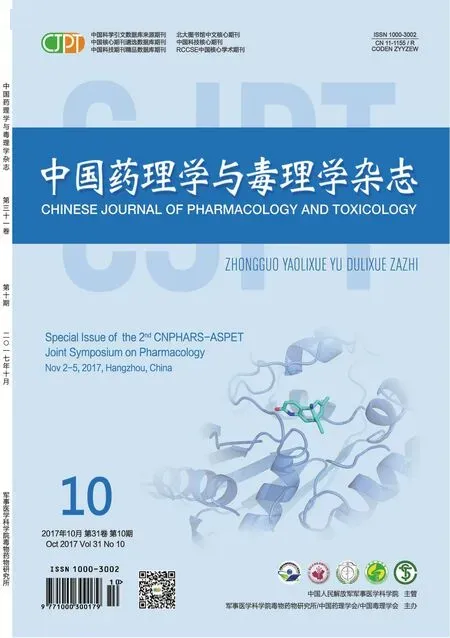Biphasic modulation of chemerin peptide-induced calcium flux and ERK phosphorylation by amyloid beta peptide
Hao GONG,Shuo ZHANG,Dan LIAO,Richard Dequan YE,2
(1.School of Pharmacy,Shanghai Jiao Tong University,Shanghai,China,200240;2.Institute of Chinese Medical Sciences,University of Macau,Macau SAR 999078,China)
T3-10
Biphasic modulation of chemerin peptide-induced calcium flux and ERK phosphorylation by amyloid beta peptide
Hao GONG1,Shuo ZHANG1,Dan LIAO1,Richard Dequan YE1,2
(1.School of Pharmacy,Shanghai Jiao Tong University,Shanghai,China,200240;2.Institute of Chinese Medical Sciences,University of Macau,Macau SAR 999078,China)
OBJECTIVEThe chemokine-like receptor 1(CMKLR1,ChemR23)is a functional receptor for chemerin,the chemerin-derived nonapeptide(C9),and the amyloid β peptide 1-42(Aβ42).Because these peptides share little sequence homology,studies were conducted to investigate their pharmaco?logical properties and regulation at CMKLR1.METHODSCells expressing CMKLR1 were incubated with Aβ42before stimulation with a strong agonist,the C9 peptide.Calcium mobilization,cAMP inhibition and MAP kinase activation were measured.Intramolecular FRET were determined using CMKLR1 constructs with an ECFP attached to the C-terminus and a FlAsH binding motif embedded in the first intracellular loop(IL1).RESULTSBinding of both Aβ42and the C9 peptide induced CMKLR1 internal?ization,but only the Aβ42-induced receptor internalization involved clathrin-coated pits.Likewise,Aβ42but not C9 stimulated β-arrestin 2 translocation to plasma membranes.A robust Ca2+flux was observed following C9 stimulation,whereas Aβ42was ineffective even at micromolar concentrations.Despite its low potency in calcium mobilization assay,Aβ42was able to alter C9-induced Ca2+flux in dose-dependent manner:a potentiation effect at 100 pmol·L-1of Aβ42was followed by a suppression at 10 nmol·L-1and further potentiation at 1 μmol·L-1.This unusual and biphasic modulatory effect was also seen in the C9-induced ERK phosphorylation but the dose curve was opposite to that of Ca2+flux and cAMP inhibition,suggesting a reciprocal regulatory mechanism.Intramolecular FRET assay confirmed that Aβ42modulates CMKLR1 rather than its downstream signaling pathways.CONCLUSIONThese findings suggest Aβ42as an allosteric modulator that can both positively and negatively regulate the activation state of CMKLR1 in a manner that differs from existing allosteric modulatory mechanisms.
Gprotein-coupled receptors;allosteric modulation;fluorescent resonance energy transfer;chemokine-like receptor 1;chemerin;conformational changes
The project supported by National Natural Science Foundation of China(31470856 to RDY);the Science and Technology Development Fund of Macau(FDCT 072/2015/A2);and the University of Macau(SRG2015-00047-ICMS-QRCM)
Richard Dequan YE.Tel:15800804313,E-mail:richardye@umac.mo
- 中國藥理學與毒理學雜志的其它文章
- Pharmacological study on traditional Chinese medicine and natural product in China
- GPCRomics:tissue and cellular GPCR expression identifies new therapeutic targets
- Direction of new drug research:soft regulation of inflammatory immune responses
- Targeting Gprotein-coupled receptors for the treatment of autoimmune diseases
- Arrestin mediated GPCR biased signaling and its application in new drug discovery
- Identification of a novel target for cancer and anti-fibrotic therapy

